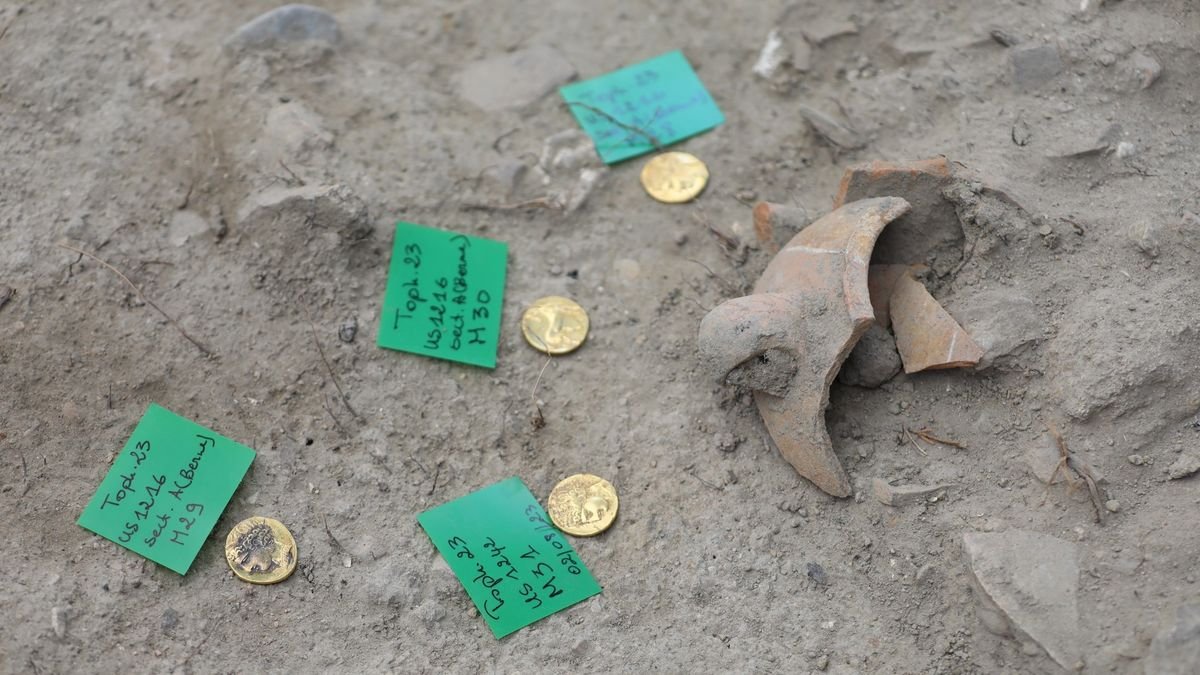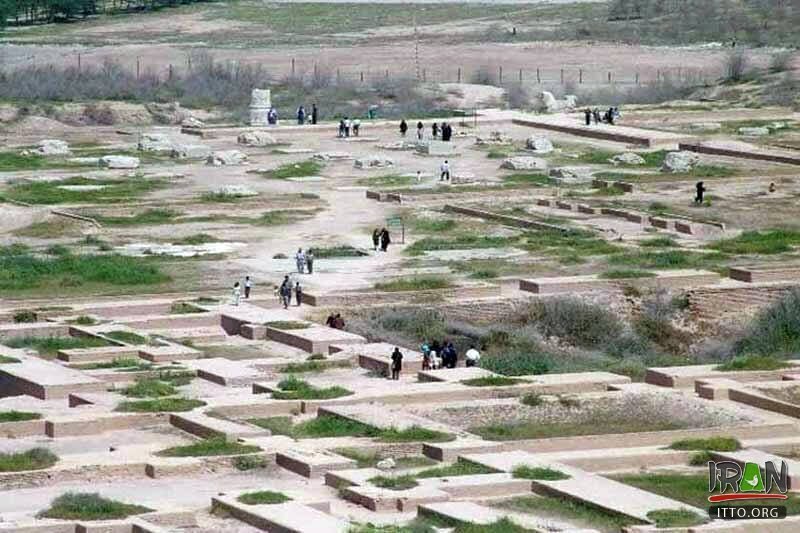Ancient Carthage uncovers rare Goddess Tanit coins
Ancient Carthage, the once-great civilization that thrived in North Africa from the 9th century BCE to the 1st century BCE, has recently unveiled a collection of rare coins featuring the goddess Tanit. These fascinating artifacts provide a glimpse into the religious and cultural practices of the Carthaginians, shedding light on their beliefs and trading networks. Let us delve into the significance of these ancient Carthaginian coins and unravel the mysteries they hold.
Five gold coins unearthed from a temple in Carthage depict the goddess Tanit and were likely left by wealthy worshippers alongside burials as an offering to gods and deities.

Discover the significance of these ancient Carthaginian artifacts
The discovery of these rare Tanit coins offers invaluable insight into the religious practices and cultural heritage of the ancient Carthaginians. Tanit, the goddess who these coins feature, was highly revered by the Carthaginians and played a central role in their religious beliefs. As the chief deity of Carthage, she represented fertility, protection, and the cycle of life. These coins, minted with her image, were likely used in religious ceremonies, as offerings, or as symbols of religious devotion.
The presence of these coins also highlights the significant role that trade played in Carthaginian society. Carthage was a major trading power in the ancient Mediterranean, known for its extensive commercial networks. The discovery of these coins suggests that they were not only used within the Carthaginian territory but also circulated in the wider Mediterranean region, indicating the influence and reach of Carthaginian trade.
Another significant aspect of these coins is their artistic value. The intricate designs and inscriptions on the coins exemplify the skilled craftsmanship of the Carthaginians. They often depicted Tanit with her distinctive headdress, a symbol of her divine status. The presence of these coins in modern times provides a tangible connection to the ancient Carthaginian civilization, offering historians and archaeologists the opportunity to study and appreciate the beauty and artistry of this ancient culture.
The unveiling of these rare Tanit coins from Ancient Carthage is an exciting development in the field of archaeology. These artifacts not only shed light on the religious practices and cultural significance of the Carthaginians but also provide valuable insights into their trade networks and artistic achievements. As research and analysis continue, we can hope to gain even further understanding of the ancient Carthaginian civilization and the role of Tanit in their society. These coins stand as a testament to the rich history and influence of Carthage, allowing us to appreciate and celebrate the cultural diversity and achievements of ancient civilizations.
Unearthing the remains of ancient civilizations has always been an exciting and enlightening endeavor for archaeologists and historians alike. The recent discoveries in Carthage have provided a unique insight into the culture and practices of the Carthaginians. Through the unearthing of burials and gold coins, we can unravel the mysteries of this ancient civilization and gain a deeper understanding of their way of life.
Uncovering Ancient Carthage: Burials and Gold Coins Revealed
Carthage, once a powerful city-state in North Africa, has captivated historians for centuries. Recent excavations have unearthed a wealth of information through the discovery of burials and gold coins. These findings shed light on the burial practices and beliefs of the Carthaginians. Intricate tombs, adorned with various artifacts and funerary offerings, provide evidence of their beliefs in the afterlife and the importance placed on honoring the deceased.
The unearthing of burials also gives us a glimpse into the social structure of Carthaginian society. The differentiation in tomb sizes and the presence of grave goods suggest a hierarchical society, where individuals of higher status were buried with more elaborate items. This reinforces the notion of social stratification within Carthage and provides valuable insights into their social dynamics.
Discovering Insights into Carthaginian Culture: Unearthed Burials and Gold Coins
In addition to burials, the discovery of gold coins has provided a fascinating window into the economic and trade practices of ancient Carthage. These coins, minted with intricate designs and inscriptions, reveal the extent of Carthaginian commerce and their interaction with neighboring civilizations. The presence of coins from different regions indicates the existence of a well-established trade network, further reinforcing Carthage’s status as a prominent economic power in the ancient world.
Moreover, the study of these gold coins offers valuable insights into Carthaginian art and craftsmanship. The designs and motifs depicted on the coins reflect the cultural influences and artistic expressions of the time. They showcase the skills of Carthaginian artisans, highlighting their mastery in metalworking and their ability to create intricate and visually stunning pieces.
The unearthing of burials and gold coins in Carthage has provided a wealth of information about the ancient civilization and its people. Through the analysis of these discoveries, archaeologists and historians can piece together the puzzle of Carthaginian culture, gaining a deeper understanding of their beliefs, social structure, and economic practices. These insights contribute to the broader narrative of the ancient Mediterranean world and allow us to appreciate the rich and complex history of Carthage.
Unveiling the Rich Tapestry of Carthage’s Historical Legacy ===
Carthage, a city steeped in ancient history, continues to captivate historians and archaeologists alike with its rich tapestry of cultural heritage. From its humble beginnings as a Phoenician colony to its status as a powerful empire, Carthage has left an indelible mark on history. In this article, we will delve into the depths of Carthage’s historical legacy, unearthing fascinating insights into its past and tracing its enduring influence to the present day.
Unearthing Carthage: A Journey into Ancient History
The exploration of Carthage’s historical legacy begins with unearthing its ancient ruins and relics. Located in modern-day Tunisia, the city’s archaeological sites have served as a treasure trove of knowledge and insight into its past. Excavations at the ancient port of Carthage have revealed the remnants of grand temples, marketplaces, and residential areas, providing a glimpse into the daily lives of its inhabitants. The preserved ruins of the Punic Ports allow us to visualize the bustling maritime trade that made Carthage a key player in the Mediterranean world. Through uncovering these artifacts and structures, we delve into a bygone era and gain a better understanding of Carthage’s cultural, social, and economic significance.
Tracing Carthage’s Influence: From Empire to Modern Discoveries
Beyond the archaeological sites, Carthage’s historical legacy extends to its significant influence on various civilizations and cultures throughout history. As one of the most formidable empires of the ancient world, Carthage’s power and reach stretched across vast territories, leaving a lasting imprint on regions such as North Africa, Sicily, and even Rome. The Punic Wars between Rome and Carthage shaped the course of history, ultimately leading to the rise of the Roman Empire. The remnants of Carthaginian influence can be seen in the architectural styles, trade networks, and cultural practices of these regions. Moreover, modern discoveries continue to shed light on Carthage’s legacy, as ongoing research and analysis provide new perspectives and insights into the city’s historical significance.
Unveiling the Rich Tapestry of Carthage’s Historical Legacy
Carthage’s historical legacy is a testament to the enduring impact of ancient civilizations on our modern world. By unearthing its ruins and studying its influence, we gain a deeper appreciation for the intricate tapestry that is Carthage’s past. As archaeologists and historians continue their exploration, the story of Carthage will continue to unfold, illuminating our understanding of the ancient world and its lasting impact on our present. The journey into Carthage’s historical legacy is a fascinating one, offering a glimpse into a vibrant culture that has left an indelible mark on human history.


